See also
- List of cheeses – List of cheeses by place of origin
Murcian cheese (Spanish : queso de Murcia) is a fatty goats' milk cheese from the Murcia region of south-east Spain. It has a Protected Designation of Origin. The cheese is made exclusively using goat's milk of the Murcian breed from registered herds which graze freely on scrub and coarse pasture characteristic of that dry geographical zone. The cheese is made in two forms:
The goats are milked daily and after filtration the milk is warmed and curdled with an animal enzyme or another authorised agent. Depending on the type of cheese to be produced the process continues thus:
For fresh cheese the milk is curdled at 32–35°C (90-93°F) for 30–45 minutes. The curd is then cut to grain of 10 millimetres (0.39 in) and the temperature is raised a further 3–5°C (37-41°F). The curd is then worked a little to make a soft consistency and transferred to moulds. The moulds have an interior pattern of rushes (Sp: plieta) which transfers to the exterior of the fresh cheeses. The cheese is pressed lightly and for short duration and then salted by immersion in brine for 10 hours, drained and kept at a maximum temperature of 4°C (39°F) until sold.
For cured cheese the milk is curdled at 30–34°C (86-93°F) for 40–60 minutes. The curd is cut to grains of 5 mm (0.20 in) and then the temperature is raised by a further 3-5°C (37-41°F). The curd is then worked quite hard to produce a harder cheese and then placed in plain moulds. It is pressed for 2–4 hours until it has reached the correct pH. The cheeses are then salted in brine for a maximum of 20 hours. Finally they are left to mature for a minimum of sixty days and sometimes much longer. [1] [2]
Both the fresh cheese and the cured cheese have a light goat flavour with a slight saltiness and slight acidity, not a complex flavour. [1] [2]
The fresh cheese is soft but firm to cut, of a very white colour and usually without cavities. [1] [2]
The cured cheese is firm to the cut, has a white to light cream colour and may have very few, small cavities. [1] [2]
The fresh cheese has almost no rind and is decorated in marks that simulate rushes.
The cured cheese rind is thin, smooth and straw-coloured to light brown. [1]
Fresh cheese may be grilled or used in cooking desserts or salads. The cured cheese is eaten sliced as a snack with beer or wine, or may be part of a meal.

Manchego is a cheese made in the La Mancha region of Spain from the milk of sheep of the Manchega breed. It is aged between 60 days and 2 years.
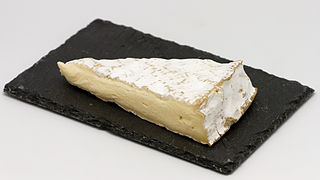
Brie is a soft cow's-milk cheese named after Brie, the French region from which it originated. It is pale in color with a slight grayish tinge under a rind of white mould. The rind is typically eaten, with its flavor depending largely upon the ingredients used and its manufacturing environment. It is similar to Camembert, which is native to a different region of France. Brie typically contains between 60% and 75% butterfat, slightly higher than Camembert.
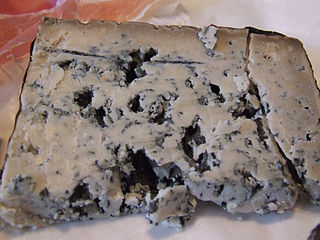
Cabrales is a blue cheese made in the artisan tradition by rural dairy farmers in Asturias, Spain. This cheese can be made from pure, unpasteurized cow’s milk or blended in the traditional manner with goat and/or sheep milk, which lends the cheese a stronger, spicier flavor.

Idiazabal is a pressed cheese made from unpasteurized sheep milk, usually from Latxa and Carranzana sheep in the Basque Country and Navarre. It has a somewhat smokey flavor, but is usually un-smoked.

Goat cheese, or chèvre, is cheese made from goat's milk. Goats were among the first animals to be domesticated for producing food. Goat cheese is made around the world with a variety of recipes, giving many different styles of cheese, from fresh and soft to aged and hard.

Leyden, from Dutch: Leidse kaas, is a semi-hard, cumin and caraway seed flavoured cheese made in the Netherlands from cow's milk. It is made both in factories and on farms, historically in the Leiden area.
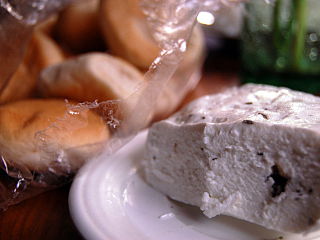
Kesong puti is a Filipino soft, unaged, white cheese made from unskimmed carabao milk and salt curdled with vinegar, citrus juices, or sometimes rennet. It can also be made with goat or cow milk. It has a mild salty and tart flavor. When an acidifying agent is used, it resembles queso blanco or paneer. When rennet is used, it resembles buffalo mozzarella. Moisture content can also vary, ranging from almost gelatinous to pressed and firm. It can be eaten as is, paired with bread, or used in various dishes in Filipino cuisine. It is usually sold wrapped in banana leaves.
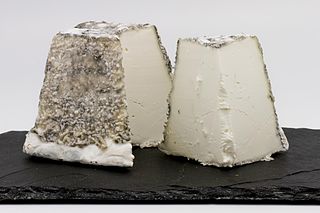
There are many different types of cheese. Cheeses can be grouped or classified according to criteria such as length of fermentation, texture, methods of production, fat content, animal milk, and country or region of origin. The method most commonly and traditionally used is based on moisture content, which is then further narrowed down by fat content and curing or ripening methods. The criteria may either be used singly or in combination, with no single method being universally used.

Picón Bejes-Tresviso is a blue cheese from Cantabria, in the north of Spain. It has been protected under Denominación de Origen (DO) legislation since 1994, prior to which it was traditionally known as Picón de Tresviso and Queso Picón de Bejes. The designated area centers in the Liébana valley and production is restricted to the municipalities of Potes, Pesaguero, Cabezón de Liébana, Camaleño, Cillorigo de Liébana, Peñarrubia, Tresviso and Vega de Liébana.

The Pallone di Gravina is a firm, semi-hard, cow's milk cheese from the regions of Basilicata and Apulia in south-east Italy. It is made in the pasta filata style weighing between 1.5 and 2.5 kg, in a pear-like shape, ball or balloon (pallone), and was traditionally produced in the area of the city of Gravina, in the Murgia area of the province of Bari. Today, however, production is centred on the province of Matera.
Alpujarras cheese is a Spanish cheese from the eastern region of Andalusia, which includes the provinces of Granada, Almería and the Penibética mountain chain. The cheese takes its name from La Alpujarra, a mountainous region which occupies a part of southern Granada province and western Almeria province. This area has a long history and tradition of goatherding. Alpujarras cheese is made from the milk of the White Andalusian domesticated goat.

Casín cheese is a Spanish cheese made in the Principality of Asturias. Its name is covered by a protected designation of origin (PDO). It is made from full-fat, unpasteurized cows' milk from specific breeds, namely Asturian Mountain, Asturian Valley (Asturiana de la Valles), Friesian and any crosses between these breeds. Specifically the geographic area of manufacture is the southern part of Asturias which includes the Redes Natural Park and associated land, this is within the municipalities of Caso, Sobrescobio and Piloña. The cheese is classified as hard and semi-hard, and can be semi-cured or cured. It takes its name from one of the breeds of cattle whose milk is used, in turn named after the town of Caso. The shape of the cheese is a thick disc-shape, sometime more conical, of 10–20 cm diameter and 4–7 cm in height. The weight is between 250 and 1,000 g.

Gamonéu cheese is a fatty Spanish cheese made in certain parts of the Principality of Asturias. Taking its name from the village of Gamonéu where it was originally made, Gamonéu cheese has a Protected Designation of Origin. It is a lightly smoked cheese with a thin, natural rind that is coloured brownish with some red, green and blue patches. Moulds on the rind slightly invade the interior of the cheese. Similar to other cheeses in the region, Gamonéu is made from a combination of cow, goat and sheep milks. Gamonéu cheese is sold in the form of cylinders with flat ends in weights varying between 500g to 7 kg (15 lbs). Gamonéu comes in two distinct forms: "del Puertu", which is made in the high passes and "del Valle", which is made in the lower valleys. Gamonéu del Puertu is harder and drier and is the rarer of the two forms as production is limited to the summer months in the uplands. Gamonéu del Valle is richer and creamer and production continues year-round.

Flor de Guía cheese is a Spanish cheese made on the island of Gran Canaria in the Canary Islands. It has Denomination of Origin protection. The cheese is classified as fatty or semi-fatty and made from the milk from Canarian sheep, with milk from Canarian cows and/or goats. The milk from the sheep must constitute at least 60% and cows’ milk content must never exceed 40%. Goat milk must never exceed 10% of the mixture. The cheese is presented in flat cylindrical cheeses which normally measure 4–8 cm high and 20–30 cm across and weighing between 2 and 5 kg. The cheese gets its name from an area in northern Gran Canaria called Santa María de Guía, where the cheese is made, and ‘flor’ from the fact that juice from the flowerheads of a species of cardoon and globe artichoke are used to curdle the milk.
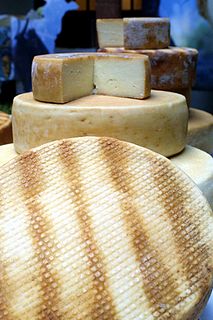
Palmero cheese is a Spanish plain or lightly smoked cheese from the island of La Palma in the Canary Islands. It is made of unpasteurised goats milk and has Denomination of Origin protection. The goats are free to graze on natural wild plants which are available all year round. The cheese is made on many small farms all over the island. It is presented in cylindrical cheeses of up to 15 kilos (33 lbs).
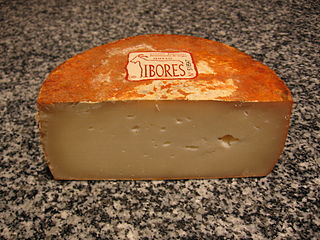
The Ibores cheese is a Spanish cheese made from unpasteurized goats’ milk in Extremadura. It has a Denomination of Origin protection in the European Union and is made specifically in the districts of Ibores, Villuercas, La Jara y Trujillo in the south east of the Province of Cáceres. It is a fatty cheese made exclusively from the milk of Serrana, Verata, Retinta breeds and crosses between them and only from farms registered with the regulatory council. The cheeses are flat cylindrical and measure 5–9 cm (2-3.5 inches) high and 11–15 cm (4-6 inches) across. They weigh from 600 to 1200 g (1-2 lbs).
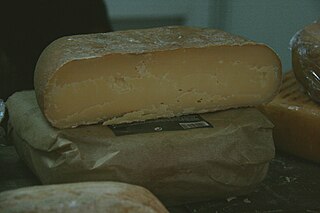
Mallorca cheese is a Spanish cheese made exclusively on the island of Mallorca, one of the Balearic Islands in the Mediterranean Sea. It has Protected Designation of Origin and is made from the pasteurized milk of cows, goats and/or sheep which live on the island. The cheeses are slightly tapering, flat cylinders which measure 12–20 cm (5-8 inches) across and 7-9 cm (3-4 inches) high. They weigh from 750 g to 4 kg (1.5-9 lbs). Mallorca cheese is produced in three types:
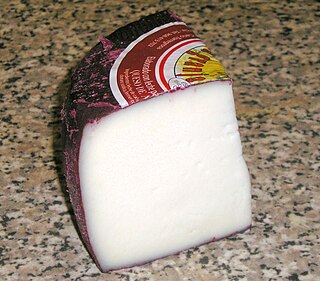
Murcian wine cheese is a fatty goats’ milk cheese from the province of Murcia in the south-east of Spain. It has a Protected Designation of Origin. The cheese is made only from unpasteurized goats’ milk of the Murcian breed from registered herds. The term al vino refers to the washing of the rind with red wine during maturation. The cheese is presented in cylinders 6–7 cm (2-3 inches) high and 7–9 cm (3-4 inches) diameter weighing 400 g, or 7–9 cm (3-4 inches) high and 12–18 cm (5-7 inches) diameter weighing 1 kg (2.2 lbs) or 2 kg (4.4 lbs).
Cantabrian cream cheese is made from the milk of Friesian cows in Cantabria, an autonomous community in northern Spain. The cheese has a Protected Designation of Origin since 1985. The production of the cheese is confined to all parts of Cantabria, except the areas of Tresviso and Menor de Bejes in the western part of the region. It is presented in forms of various weights from 400 – 2,800 g. The size of the forms varies according to the weight.